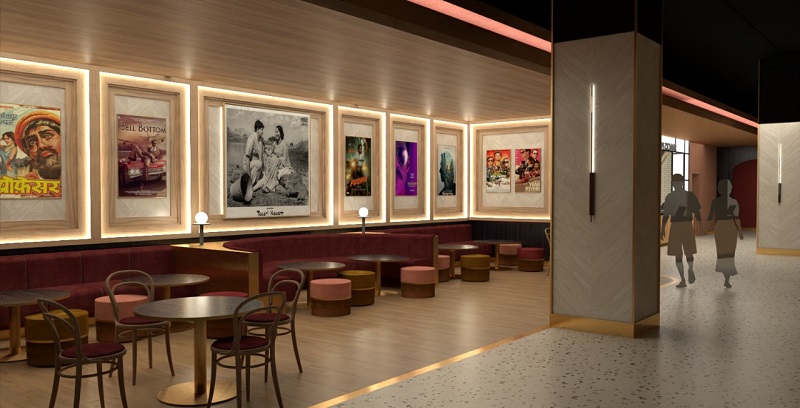Cinemax, which started its journey in 2002, was recently relaunched in its new avatar, MovieMax. The reopening of theaters post pandemic has been a refreshing change for the movie goers and it served as a great opportunity for the company, as the movie halls have been quenching the thirst of the entertainment lovers after a long gap.
Over 6,000 people will be able to enjoy a first-class theatre experience at MovieMax on the 23 screens spread across Mumbai, Thane, Nashik, and Nagpur following the initial rollout. The company aims to gradually expand their entertainment business across the country.
In a detailed interview with Animation Xpress, the Cineline India Ltd (part of the Kanakia Group) chairman Rasesh Kanakia explains how the company with a long experience in theatre exhibition business is planning to tap the growing entertainment market.
1. Cineline Entertainment was incorporated in 2002. Tell me something about the journey back then.
Cineline India was formerly known as Cinemax and the company was engaged in the theatre exhibition business for operating cinema theatres. In 2002, Cinemax India was incorporated as Cineline Entertainment and we focused on multiplex theatres and entertainment centers. In 2005, our name was changed to Cinemax Cinemas and after becoming a public company in 2006, the name was changed to Cinemax India. From having 52 screens in 2008 to 75 screens in 2022, the company has come a long way.
2. Please talk about the revenues, ticket pricing and cinema experience being provided to the audience, back then and how things have changed over the years.
Our vision to grow in the film exhibition industry has always remained the same since the time we first stepped into this segment. A lot has changed since then, but over the years, we have seen how technology and digital have helped transform the entire film viewing experience. The footfall in theatres is highly dependent on the content quality for generating higher revenues. Hence, the revenues and ticket pricing depend on the content and the cast of the films to have a successful run at the theaters. In comparison to today, earlier the ticket prices were very low, while today, the convenience to book tickets has eased the overall film viewing experience. Today, the rise in premium screenings and luxury cinemas has provided a richer movie-going experience to patrons.
3. The multiplex business under the brand name ‘Cinemax’ was sold to PVR in 2012. What made you consider the comeback in this new avatar?
The film exhibition is of a fluctuating and volatile nature. This is due to the shifting content and changing perceptions of the audiences. However, there has been a massive transformation in how single-screen film exhibition is giving way to a premium experience to view films. We are in the process of consolidating our position in the industry as film theater exhibitors. We have a long history of managing film theaters and are now tapping into the growing entertainment market. This reentry gives us a boost to our consumer-oriented brand identity and helps us capitalize on the tremendous growth to expand our footprint in the organized segment.
4. How is MovieMax different from Cinemax? Will you be having 3D, 4DX screens/halls as well?
Unlike Cinemax, MovieMax will provide a superior viewing experience with premium screenings, as well as 3D screenings across several locations. We are also working to expand the selection of food available inside the theatres. With the huge opportunity in the market, we are looking to grow exponentially in this space.
5. Post-pandemic the footfalls at the theatres have been affected. Do you think this is the right time to reconsider the film exhibition business?
As a result of the restrictions placed on the industry due to the COVID-19 pandemic, the film industry suffered significantly. With the latest relaxation in place, the industry is experiencing a resurgence and boom in opportunities in the film exhibition business. Hollywood, Bollywood, and regional content are bolstering the film industry’s market share. We saw this opportunity and decided to seize it in order to keep up with consumer demand. To entice moviegoers to return to the theatres, filmmakers are preparing to release high-profile productions that are set to attract people back to the theatres. We are confident that the film industry will thrive in the long run, based on the success of big-budget commercial films like Sooryavanshi and Pushpa.
6. In the first phase MovieMax Cinemas will be opening in Mumbai, Thane, Nagpur and Nashik. After the initial launch, when and how do you plan to spread across the country?
Over 6,000 people will be able to enjoy a first-class theatre experience on these 23 screens in Mumbai, Thane, Nashik, and Nagpur following the initial rollout. With a total capacity of 16,500 seats, we have currently 75 screens across the country. We see a clear opportunity and space for an organized pan India player to deliver a high-quality experience to audiences. In the near future, we intend to expand our presence in India by acquiring more screens and establishing a strong consumer brand identity. Additionally, we’ve begun identifying additional screens in other Indian cities as well.
7. What are your novel plans for ‘MovieMax’? What marketing strategies have you been using to attract the audience?
Rebranding ourselves as MovieMax was an extension of our strong brand presence in the movie exhibition industry. We wanted to take this opportunity to step back into this space as the lease on our screens had expired. MovieMax is going to differ in that as it will provide our audiences with a premium experience. We intend to have MovieMax to be resonated as a strong consumer-centric brand that is leveraging its strong foothold in Maharashtra with a pan India expansion strategy.
8. With the new trend of direct-to-digital movie releases, less number of films are coming to the cinemas. How do you plan to tackle this?
We believe that some movies will be released digitally, while others will be shown in theatres. We have one of the biggest film industries in the world where around eight to nine films are released every weekend. Both these distribution methods will remain relevant in the future. Direct to digital releases will help both platforms to attract audiences as we are witnessing an influx of large audiences on OTT and theatres. Going forward, both platforms will co-exist and grow as they are catering to a wider set of age groups and demographics. It has been decades since the rise of the DVD and video cassette but still, the cinemas have not been impacted. Indians have always enjoyed going to theatres and this behaviour will continue to grow even in the future. This is because enjoying a film in the theatres is close to a luxurious experience and very different from an OTT experience.
9. Do you think action and sci-fi films will garner more eyeballs in theatres and the drama content is more suited for digital platform release?
For those who enjoy action and sci-fi films, the experience is more important than the story, while drama films have a more complex storyline that can be enjoyed in one’s own space. While every narrative and story will have its own merits, the tech-based value adds are higher for action and sci-fi films. Given the emergence of VFX and CGI in the mix, these genres are more preferred to be experienced by moviegoers. Drama on the other hand does offer the option to view in one’s own comfort and space. However, both these genres will witness a certain degree of overlap across the mediums.
10. Also, OTT platforms costs are cheaper compared to movie tickets due to which families prefer watching movies at home. What are your thoughts about it and what will be the pricing of the tickets and food and beverages?
Access to high-quality content from around the world is a major perk of (OTT) platforms. OTT platforms are cost-effective given the economics of consumption. However, certain 3D films will not be easily replaced by the OTT platform. Even though binge-watching content in the comfort of our homes has become a norm, cinema-goers, who have grown accustomed to watching content online, remain steadfast in their devotion to the art form. The food and beverage space is a major area where a wider variety of items with economical pricing will increase overall consumption.


